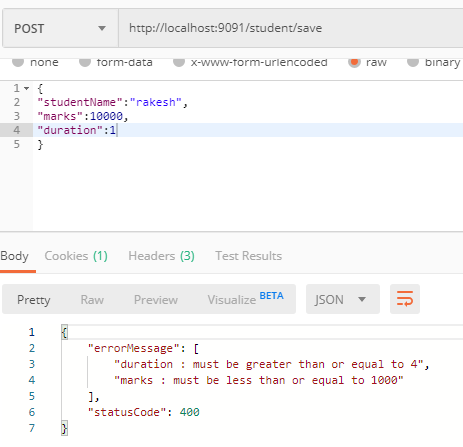In this post, we will see @Min And @Max Javax Validation Hibernate Example Using Spring Boot.
{
"studentName":"rakesh",
"marks":1000,
"duration":4
}
response
{
"id": 2,
"studentName": "rakesh",
"duration": 4,
"marks": 1000
}
Invalid Request
{
"studentName":"rakesh",
"marks":10000,
"duration":3
}
{
"errorMessage": [
"duration : must be greater than or equal to 4",
"marks : must be less than or equal to 1000"
],
"statusCode": 400
}
@Entity
public class Student {
@Id
@GeneratedValue(strategy = GenerationType.AUTO)
private int id;
@Column(name = "student_name")
private String studentName;
@Column(name = "duration")
@Min(4)
private int duration;
@Column(name = "marks")
@Max(1000)
private int marks;
}
Let’s see @Min And @Max Javax Validation Hibernate Example from scratch. After running below example, we will be able to save an entity in the database if we have valid request data else it will show the validation error message.
Valid Request Data –

Invalid request data –

Open eclipse and create maven project, Don’t forget to check ‘Create a simple project (skip)’ click on next. Fill all details as below and click on finish.
Modify pom.xml
<project xmlns="http://maven.apache.org/POM/4.0.0"
xmlns:xsi="http://www.w3.org/2001/XMLSchema-instance"
xsi:schemaLocation="http://maven.apache.org/POM/4.0.0 http://maven.apache.org/xsd/maven-4.0.0.xsd">
<modelVersion>4.0.0</modelVersion>
<groupId>hibernatevalidatorexample</groupId>
<artifactId>hibernatevalidatorexample</artifactId>
<version>0.0.1-SNAPSHOT</version>
<name>hibernatevalidatorexample</name>
<parent>
<groupId>org.springframework.boot</groupId>
<artifactId>spring-boot-starter-parent</artifactId>
<version>2.0.2.RELEASE</version>
</parent>
<dependencies>
<dependency>
<groupId>org.springframework.boot</groupId>
<artifactId>spring-boot-starter-web</artifactId>
</dependency>
<dependency>
<groupId>org.springframework.boot</groupId>
<artifactId>spring-boot-starter-data-jpa</artifactId>
</dependency>
<dependency>
<groupId>com.oracle</groupId>
<artifactId>ojdbc6</artifactId>
<version>11.2.0.3</version>
</dependency>
</dependencies>
<build>
<finalName>${project.artifactId}</finalName>
<plugins>
<plugin>
<artifactId>maven-compiler-plugin</artifactId>
<version>3.1</version>
<configuration>
<fork>true</fork>
<executable>C:\Program Files\Java\jdk1.8.0_131\bin\javac.exe</executable>
</configuration>
</plugin>
</plugins>
</build>
</project>
Note – In pom.xml we have defined javac.exe path in configuration tag. You need to change accordingly i.e where you have installed JDK.
If you see any error for oracle dependency then follow these steps.
Directory structure –
Student.java
package com.entity;
import java.math.BigDecimal;
import javax.persistence.Column;
import javax.persistence.Entity;
import javax.persistence.GeneratedValue;
import javax.persistence.GenerationType;
import javax.persistence.Id;
import javax.validation.constraints.Digits;
@Entity
public class Student {
@Id
@GeneratedValue(strategy = GenerationType.AUTO)
private int id;
@Column(name = "student_name")
private String studentName;
@Column(name = "fee")
@Digits(integer = 4, fraction = 2)
private BigDecimal fee;
public int getId() {
return id;
}
public void setId(int id) {
this.id = id;
}
public String getStudentName() {
return studentName;
}
public void setStudentName(String studentName) {
this.studentName = studentName;
}
public BigDecimal getFee() {
return fee;
}
public void setFee(BigDecimal fee) {
this.fee = fee;
}
}
StudentController.java
package com.controller;
import org.springframework.beans.factory.annotation.Autowired;
import org.springframework.web.bind.annotation.RequestBody;
import org.springframework.web.bind.annotation.RequestMapping;
import org.springframework.web.bind.annotation.RequestMethod;
import org.springframework.web.bind.annotation.ResponseBody;
import org.springframework.web.bind.annotation.RestController;
import com.entity.Student;
import com.service.StudentService;
@RestController
@RequestMapping(value = "/student")
public class StudentController {
@Autowired
private StudentService studentService;
@RequestMapping(value = "/save", method = RequestMethod.POST)
@ResponseBody
public Student saveBook(@RequestBody Student student) {
Student studentResponse = (Student) studentService.saveStudent(student);
return studentResponse;
}
}
StudentRepository.java – interface
package com.repository;
import java.io.Serializable;
import org.springframework.data.repository.CrudRepository;
import org.springframework.stereotype.Repository;
import com.entity.Student;
@Repository
public interface StudentRepository extends CrudRepository<Student,Serializable> {
}
StudentService.java – interface
package com.service;
import org.springframework.stereotype.Component;
import com.entity.Student;
@Component
public interface StudentService {
public Student saveStudent(Student student);
}
StudentServiceImpl.java
package com.impl;
import java.util.ArrayList;
import java.util.List;
import java.util.Set;
import javax.validation.ConstraintViolation;
import javax.validation.ConstraintViolationException;
import javax.validation.Validation;
import javax.validation.Validator;
import org.springframework.beans.factory.annotation.Autowired;
import org.springframework.stereotype.Service;
import com.entity.Student;
import com.repository.StudentRepository;
import com.service.StudentService;
@Service("studentServiceImpl")
public class StudentServiceImpl implements StudentService {
@Autowired
private StudentRepository studentRepository;
@Override
public Student saveStudent(Student student) {
validateEntity(student);
Student studentresponse = studentRepository.save(student);
return studentresponse;
}
private void validateEntity(Student student) {
List<String> errorMessage = new ArrayList<>();
Validator validator = Validation.buildDefaultValidatorFactory().getValidator();
Set<ConstraintViolation<Student>> constraintViolations = validator.validate(student);
for (ConstraintViolation<Student> constraintViolation : constraintViolations) {
errorMessage.add(constraintViolation.getMessage());
}
if (errorMessage.size() > 0) {
throw new ConstraintViolationException(constraintViolations);
}
}
}
GlobalErrorHandler.java – Let’s define a error handler class. This class will be used when validateEntity() method will throw ConstraintViolationException(See more details about GlobalErrorHandler here).
package com.controller;
import java.util.List;
import java.util.ArrayList;
import javax.validation.ConstraintViolation;
import javax.validation.ConstraintViolationException;
import org.springframework.http.HttpStatus;
import org.springframework.web.bind.annotation.ControllerAdvice;
import org.springframework.web.bind.annotation.ExceptionHandler;
import org.springframework.web.bind.annotation.ResponseBody;
import com.entity.ResponseError;
@ControllerAdvice
public class GlobalErrorHandler {
@ExceptionHandler(ConstraintViolationException.class)
@ResponseBody
public ResponseError handleCustomException(ConstraintViolationException ex) {
ResponseError responseError = new ResponseError();
List<String> errorMessages = new ArrayList();
for (ConstraintViolation constraintViolation : ex.getConstraintViolations()) {
errorMessages.add(constraintViolation.getPropertyPath() + " : " + constraintViolation.getMessage());
}
responseError.setErrorMessage(errorMessages);
responseError.setStatusCode(HttpStatus.BAD_REQUEST.value());
return responseError;
}
}
ResponseError.java
package com.entity;
import java.util.List;
public class ResponseError {
private List<String> errorMessage;
private int statusCode;
public List<String> getErrorMessage() {
return errorMessage;
}
public void setErrorMessage(List<String> errorMessage) {
this.errorMessage = errorMessage;
}
public int getStatusCode() {
return statusCode;
}
public void setStatusCode(int statusCode) {
this.statusCode = statusCode;
}
}
SpringMain.java
package com.main;
import org.springframework.boot.SpringApplication;
import org.springframework.boot.autoconfigure.SpringBootApplication;
import org.springframework.boot.autoconfigure.domain.EntityScan;
import org.springframework.context.annotation.ComponentScan;
@SpringBootApplication
@ComponentScan(basePackages = "com.*")
@EntityScan("com.entity")
public class SpringMain {
public static void main(String[] args) {
SpringApplication.run(SpringMain.class, args);
}
}
JpaConfig.java
package com.config;
import org.springframework.context.annotation.Configuration;
import org.springframework.data.jpa.repository.config.EnableJpaRepositories;
@Configuration
@EnableJpaRepositories(basePackages = "com.repository")
public class JpaConfig {
}
application.properties
# Connection url for the database spring.datasource.url=jdbc:oracle:thin:@localhost:1521:XE spring.datasource.username=SYSTEM spring.datasource.password=oracle2 spring.datasource.driver-class-name=oracle.jdbc.driver.OracleDriver # Show or not log for each sql query spring.jpa.show-sql = true spring.jpa.hibernate.ddl-auto =create spring.jpa.properties.hibernate.dialect = org.hibernate.dialect.Oracle10gDialect server.port = 9091
Let’s run the SpringMain class(run as java application).
That’s all about @Min And @Max Javax Validation Hibernate Example Using Spring Boot.
You May like.
- Hibernate Validator Constraints Example Using Spring Boot.
- @ControllerAdvice Global Error Handling Example in Spring Boot.
- @ExceptionHandler Example in Spring Boot.
- Spring Data JPA greater than Example
- Spring Data JPA less than Example
- Spring Data JPA IsNull Example Using Spring Boot
- Spring Data findById() Vs getOne()
- Spring Data JPA CrudRepository findById()
- Spring Data JPA JpaRepository getOne()
- Spring Data CrudRepository saveAll() and findAll().
- Spring Data CrudRepository existsById()
- Spring Data JPA delete() vs deleteInBatch()
- Spring Data JPA deleteAll() Vs deleteAllInBatch()
- Spring Data JPA JpaRepository deleteAllInBatch()
- Spring Data JPA deleteInBatch() Example
- Spring Data JPA JpaRepository saveAndFlush() Example
- Spring Data JPA CrudRepository count() Example
- Spring Data JPA CrudRepository delete() and deleteAll()
- Spring Data JPA CrudRepository deleteById() Example
- CrudRepository findAllById() Example Using Spring Boot
- Spring Data CrudRepository save() Method.
- Sorting in Spring Data JPA using Spring Boot.
- Spring Data JPA example using spring boot.
- Spring Data JPA and its benefit.
Spring Data JPA Docs.





